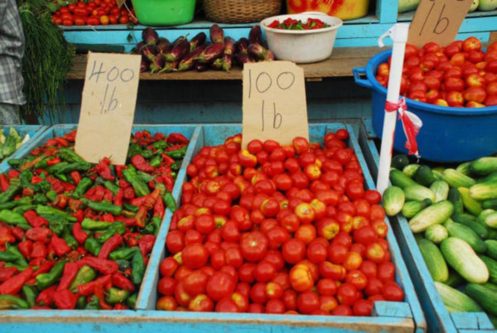The performance of the “other crops” segment of Guyana’s agricultural sector during the first four months of 2017 has come in for high praise from the National Agricultural Research and Extension Institute (NAREI) in a recent review of the sector for the first four months of this year seen by the Stabroek Business.
The report asserts that other crops “performed exceptionally well,” stating that “farmers have reportedly produced maximum capacity resulting in an abundance of fresh fruits and vegetables on the local markets at affordable prices.”
NAREI’s assessment is consistent with observations made by the Stabroek Business based on a review of the availability and prices of greens and vegetables at city municipal markets undertaken by the newspaper in April. Subsequently, in its April 14 issue the Stabroek Business reported on the surfeit of traditional greens and vegetables at uncharacteristically low prices.


The NAREI report attributed the bountiful harvest of the first four months of this year to a number of factors including “no outbreak of pests or diseases; weather conditions conducive to farming; incorporation of technologies in farming practices and continuous technical support from NAREI.”
And in pursuit of its effort to further support food production through the agricultural sector NAREI says that it has established demonstration farms in each of the ten administrative regions of the country which are being used to “educate farmers using the farmers’ field school approach on improved production practices for fruits and vegetables.” The schools will provide continuous support for groups of farmers including the West Coast Berbice women’s group that benefited from shade houses last year and will also support the community of St Francis in the creation of ten green/shade houses.
The Institute says in its review that it is currently implementing its work programme for this year which it says is strategically crafted to achieve the objectives of the overall Strategic Plan for 2013-2020. Central to that Plan, the Review says are the national diversification programme, the application of climate smart practices in the sector, the prudent use of bio-pesticides in agriculture, integrated pest management, the creation of demonstration farms and the application of supportive pest management techniques.
Setting aside the reported breakthrough in Irish potatoes and onions (which has also been reported in the Stabroek Business) the diversification dimension to the NAREI review says that the cultivation of new varieties of cassava, breadfruit, watermelon and plantain are among the “priority crops” for the Institute this year. It says that the current long-term plans to guide the introduction of these new varieties into the local cash crop sector are proceeding simultaneously with plans for phased imports reduction.
NAREI says that trials are already being conducted to determine “yield and yield components” of new and improved varieties of cassava.
Meanwhile, the review says that in response to a call made by President David Granger for increased breadfruit production to boost the agro processing sector, an exercise in plant distribution has already commenced. NAREI says that its plans to support the initiative include the intended creation of a five-acre breadfruit plantation at Bartica.
Meanwhile, the Institute says in its review that it continues to evaluate the progress of the Black Sigatoka Disease-resistant plantain and banana cultivars established in 2016. It says that some of these are “showing promise.”
NAREI says that it is also paying close attention to “crop protection” in the context of its contribution to the agricultural sector and that in this context it is monitoring for the Carambola Fruit Fly and the application of Jackson Traps (a low-cost mechanism for the eradication of fruit flies and other pests) continues from Mahaica and Ithaca in Region Five and in communities in Region Four, along the Soesdyke/Linden Highway.
The NAREI review also disclosed that CARDI has also been lending support in identifying pests affecting coconut trees and that the agency had detected various types during a visit to the Pomeroon area. The Institute says that in the light of the continued presence of the Red Palm Mite in the coconut industry it had distributed chemicals to one hundred and ninety seven coconut farmers in the Pomeroon, East Coast Demerara and Wakenaam.




